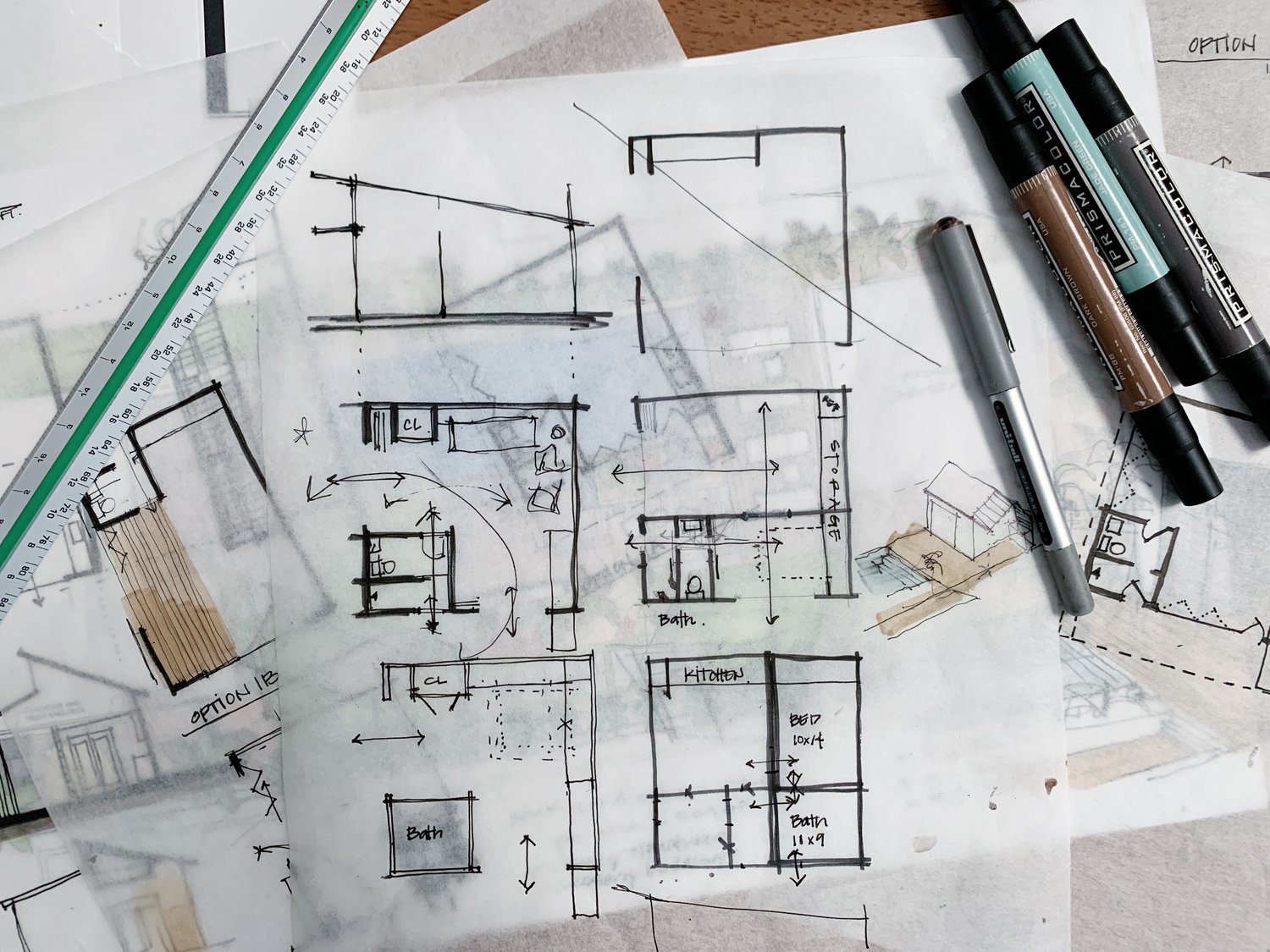Architect Advice on Maximizing Small Urban Spaces
Architect Advice on Maximizing Small Urban Spaces
Blog Article
Comprehending the Diverse Career Paths Available for Aspiring Architect
As a hopeful Architect, you have a world of occupation paths waiting on you. Each path offers distinct challenges and opportunities to apply your creativity and technical expertise. Whether you're drawn to typical style or the subtleties of lasting layout, there's a specific niche that lines up with your passions. Comprehending these varied options can shape your expert journey, however which instructions will you choose to explore first?
Standard Style: Designing Buildings and Frameworks
Typical design focuses on making buildings and frameworks that blend functionality with visual appeal. As you explore this area, you'll value the detailed balance in between type and function. You'll discover to draw ideas from historical designs, incorporating elements like symmetry, products, and workmanship. Your layouts can mirror cultural heritage, showcasing regional customs while meeting modern requirements.
You'll establish skills in drafting, model-making, and site analysis, enabling you to envision and communicate your ideas properly. Engaging with clients, you'll require to comprehend their vision and convert it right into possible designs.
Additionally, developing codes and sustainability practices are essential in your job, guaranteeing your structures are ecologically pleasant and safe. As you expand in your profession, you'll discover chances in domestic, commercial, or perhaps restoration tasks, each offering special obstacles. Accepting standard design leads the way for a satisfying career that pays tribute to the past while shaping the future.
Urban Planning: Forming Communities and Public Spaces
As an ambitious Architect, you can play an important function as a metropolitan coordinator, transforming how neighborhoods work and interact. By using area involvement strategies, you'll guarantee that residents have a voice in forming their atmosphere. Plus, incorporating lasting style principles will certainly assist create rooms that not only meet today's demands however likewise shield the future.
Role of Urban Planners
While several might think of designers as the single enthusiasts behind structures, metropolitan organizers play an essential duty in forming the broader landscape of areas and public spaces. By working together with numerous stakeholders, you'll help create parks, transport systems, and property areas that advertise social interaction and accessibility. Your know-how in spatial layout and area characteristics enables you to picture future growth while preserving social heritage.
Neighborhood Engagement Strategies
Effective neighborhood involvement techniques are vital for urban coordinators to guarantee that the voices of homeowners are heard and valued in the planning procedure. To cultivate purposeful discussion, you should prioritize open online forums and workshops where neighborhood members can reveal their ideas and issues. Usage surveys and social networks to get to a wider audience, making certain diverse perspectives are included. Teaming up with regional companies can enhance depend on and promote much deeper links. It is necessary to offer clear info concerning decision-making procedures and proposed jobs, enabling citizens to feel informed and equipped. By actively including and paying attention comments, you'll produce spaces that show the community's demands, eventually leading to more sustainable and effective urban settings. Welcome openness and continuous discussion for long-term influence.
Lasting Layout Principles
When creating city spaces, including sustainable layout concepts is essential for developing settings that prosper both ecologically and socially. You need to begin by concentrating on power efficiency, utilizing products that lower waste and promote recycling. Think about incorporating eco-friendly areas, like yards and parks, to enhance biodiversity and boost air high quality. Promoting walkability and public transport can minimize dependence on cars and trucks, fostering a much healthier area.
Creating with water preservation in mind is also vital-- think of rainfall gardens and absorptive surface areas to take care of stormwater. Including neighborhood members during the planning procedure assurances that the spaces you create satisfy their needs and urge social interaction. By welcoming these principles, you'll add to vivid, lasting city landscapes that profit everyone.

Landscape Architecture: Producing Sustainable Exterior Atmospheres
As you discover landscape style, you'll discover important style concepts that create useful and lovely outdoor areas. Lasting techniques play an essential duty in ensuring these environments prosper while reducing environmental influence. And also, you'll discover a range of job chances that allow you to make an actual distinction in exactly how individuals connect with nature.
Design Concepts in Landscape
Comprehending design principles in landscape architecture is important for producing lasting outdoor atmospheres that balance with nature. You'll require to consider components like percentage, range, and balance to ensure your designs feel cohesive and welcoming. In addition, pay attention to seasonal changes, making with materials that complement the surroundings year-round.
Lasting Practices Review
Lasting practices in landscape architecture not only concentrate on looks however additionally prioritize eco-friendly wellness and source preservation. By incorporating indigenous plants, you enhance biodiversity and decrease the requirement for chemical plant foods and pesticides. Executing effective irrigation systems helps save water and lessens runoff, protecting close-by environments. You can develop spaces that promote dirt health and wellness, such as using natural products and practicing permaculture principles. Furthermore, integrating eco-friendly infrastructure, like rainfall yards and porous sidewalks, help in stormwater management and decreases urban heat. When you develop outside atmospheres with sustainability in mind, you add to a healthier earth and provide rooms that foster neighborhood connection. Eventually, these methods ensure your layouts benefit both people and the atmosphere for years ahead.
Occupation Opportunities Exploration
With a solid structure in sustainable techniques, landscape style offers a range of occupation courses that permit you to make a purposeful impact on the environment. You could function as a landscape developer, developing cosmetically pleasing and useful exterior rooms, or concentrate on ecological restoration, helping to restore damaged environments. Urban planners usually team up with landscape engineers to produce green spaces in metropolitan settings, enhancing city livability. If you're passionate about education, consider ending up being a landscape style teacher, inspiring future generations. Additionally, you may collaborate with nonprofits focused on environmental sustainability or take part in study to innovate new practices. Each path not just shapes attractive atmospheres but also promotes a healthier world for future generations.
Sustainable Layout: Concentrating On Eco-Friendly Practices
As you explore your career in architecture, welcoming eco-friendly methods can establish you apart in an affordable area. Lasting layout focuses on creating buildings that decrease environmental influence while improving owner health. By including renewable products, energy-efficient systems, and sustainable building techniques, you'll add to a greener future.
Begin by gaining expertise of eco-friendly certifications like LEED or BREEAM, which can bolster your qualifications. Consider exactly how all-natural light, ventilation, and thermal efficiency can enhance design. Work together with company website designers and environmental professionals to innovate services that reduce waste and conserve sources.
Do not forget the relevance of community participation-- appealing regional stakeholders can inspire styles that harmonize with the setting. As clients significantly focus on sustainability, your expertise in eco-friendly techniques will not only bring in jobs yet likewise satisfy your passion for accountable architecture. Welcome this vital aspect of the occupation, and see your job thrive.
Historic Conservation: Protecting and Bring Back Cultural Heritage
While you commence on your architectural journey, consider the essential function of historic preservation in keeping our cultural heritage. This area concentrates on the defense and repair of significant structures, sites, and structures that tell the stories of our past. By engaging in historic conservation, you'll aid safeguard the architectural tradition that shapes area identification.
As a historical preservation Architect, you'll evaluate historical value and evaluate the problem of structures. You'll function closely with guardians and chroniclers to ensure authentic reconstruction strategies are utilized. This occupation path allows you to blend creativity with research, allowing you to design services that appreciate original products and craftsmanship.
Your job not just adds to sustainability by reusing existing buildings yet likewise cultivates a feeling of pride within areas. Embracing this path will assist you become a guardian of background, preserving the stories and appearances that improve our lives.
Interior Style: Enhancing Indoor Spaces
Historical preservation and interior architecture both share a commitment to enhancing the built atmosphere, but they concentrate on different aspects. While historical conservation stresses preserving a structure's historical and cultural value, indoor style absolutely nos in on enhancing interior areas for functionality and appearances.
As a hopeful Architect, you'll find that indoor style allows you to blend creative thinking with technical abilities. You'll develop areas that not just look great but also advertise convenience and effectiveness. This field entails recognizing exactly how light, color, and materials connect within a room, influencing state of mind and functionality.
You'll work with numerous projects, from domestic homes to commercial offices, making sure that each environment fulfills the demands of its passengers. By prioritizing user experience, you can transform interiors right into practical and inspiring rooms, making a substantial influence on exactly how individuals engage with their surroundings. Welcome the chance to improve interior environments and shape the means people work and live.
Industrial Design: Combining Functionality With Appearances
Commercial style plays an important role in creating look at this web-site products that effortlessly blend looks with capability, making certain that what you utilize day-to-day is not only visually attractive yet also functional. As an check this site out aspiring Architect, you could immerse on your own in this field, concentrating on developing every little thing from furnishings to consumer electronics. Your job entails understanding individual demands, materials, and making procedures, permitting you to create cutting-edge solutions that improve everyday experiences.
In commercial design, you'll usually collaborate with makers, marketing professionals, and engineers, making sure that your designs are not only lovely yet additionally possible. You'll discover to balance type and feature, focusing on functionality without sacrificing style. By sharpening your skills in laying out, 3D modeling, and prototyping, you'll be well-appointed to bring your ideas to life. This occupation course supplies a vibrant environment where creativity satisfies usefulness, making it a gratifying option for designers curious about forming the products of tomorrow.
Often Asked Questions
What Educational Accreditations Do I Need to Become an Engineer?
To come to be a designer, you'll require a professional level in architecture, generally a Bachelor's or Master's. In addition, you'll have to finish an internship and pass the Architect Enrollment Exam to practice lawfully.
Are There Accreditation Demands for Various Building Occupation Paths?
Yes, there're accreditation needs for numerous architectural paths. Architect. You'll require to pass exams, complete internships, and occasionally seek specialized training, depending upon your selected emphasis, like landscape design, metropolitan layout, or historic conservation
What Software Skills Are Important for Engineers Today?

How Can I Gain Practical Experience While Studying Architecture?
You can get functional experience by interning at building companies, taking part in design competitions, offering for neighborhood tasks, or collaborating with classmates on real-world jobs. These opportunities boost your abilities and develop valuable links in the market.
What Task Opportunities Exist Outdoors Standard Style Firms?
You can discover different job opportunities outside traditional architecture companies, like city planning, indoor design, landscape design, building administration, realty growth, and even duties in sustainability consulting. Each offers distinct obstacles and incentives.
Whether you're attracted to standard architecture or the nuances of sustainable design, there's a particular niche that lines up with your passions.When making metropolitan rooms, integrating sustainable layout concepts is vital for creating atmospheres that grow both environmentally and socially.As you explore landscape style, you'll uncover crucial style concepts that develop stunning and practical outdoor areas.Comprehending layout principles in landscape style is vital for producing sustainable outdoor settings that integrate with nature.In industrial layout, you'll often collaborate with makers, engineers, and marketing experts, making sure that your styles are not just beautiful yet also possible.
Report this page